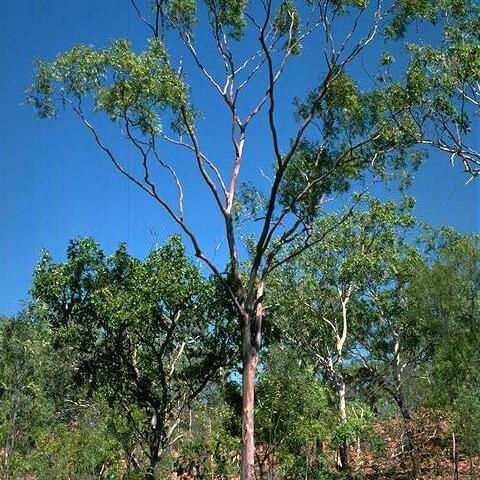Tree to 12 m tall. Forming a lignotuber.Bark smooth throughout, or the trunk rough, flaky to tessellated, grey for up to 3 m then becoming smooth. The smooth bark is sometimes powdery, creamy white to orange-brown.Branchlets often have discrete, round oil glands in the pith; non-glaucous, smooth (glabrous).Juvenile growth (coppice or field seedlings to 50 cm): stems rounded in cross-section, setose to scabrid with the remains of bristle-glands; juvenile leaves shortly petiolate, opposite, sub-opposite or alternate, ovate to elliptical, 4.5–9 cm long, 2–6 cm wide, base lobed on lowest leaves becoming rounded higher up stem, green, sparsely setose on lamina, more so on petiole.Adult leaves opposite, sub-opposite or alternate, petioles 0.4–1.6 cm long; blade linear to narrowly lanceolate, (5.8)8–21 cm long, 0.6–1(2.5) cm wide, base tapering to petiole, margin entire, apex pointed, concolorous, glabrous, thin-textured, slightly glossy, green, side-veins usually at greater than 45° to midrib, reticulation dense to very dense, intramarginal vein present, oil glands clearly visible, island.Inflorescence usually axillary, sometimes on (now) leafless sections of branchlet (ramiflorous), compound, the rhachis with a short basal internode (to 0.5 cm) then short and congested upper internodes, and peduncles which may be 0–1.0 cm long, strictly with the umbels in 7s but apparently up to 11s or 13s, the actual number difficult to discern because of the reduction of peduncles; buds on slender pedicels 0.5–1.5 cm long. Mature buds obovoid to pyriform, 0.4–0.6 cm long, 0.3–0.5 cm wide, smooth and glossy, scar present (outer operculum shed early), operculum shallowly rounded, stamens inflexed, all fertile, anthers oblong, dorsifixed, versatile, dehiscing by longitudinal slits, style long and straight, stigma ± blunt, locules 3 or 4, ovules not arranged in clear rows on the placentae. Flowers white.Fruit pedicellate (pedicels 0.6–1.5 cm long), cylindrical to barrel-shaped, 0.8–1 cm long, 0.4–0.8(1.0) cm wide, thin-walled, disc descending vertically, valves 3 or 4, enclosed.Seeds reddish brown, saucer-shaped, 3–5 mm diameter, smooth, hilum ventral. Cultivated seedlings (measured at ca node 10): cotyledons reniform, stems rounded in cross-section, densely setose with fine, long bristle-glands; leaves always shortly petiolate, opposite, ovate to elliptical, 8–10.3 cm long, 2–4 cm wide, base rounded or tapering to petiole, margin entire, apex bluntly pointed, green, setose especially on midrib and margin.
More
Tree to 10 m. Bark tessellated, grey to 3 m, smooth and cream-yellow or cream-orange above. Juvenile leaves broadly lanceolate. Adult leaves subopposite to alternate, petiolate, lanceolate, apiculate; lamina 10–21 cm long, 1–2.5 cm wide, green, concolorous; lateral veins at 50°–60°; intramarginal vein up to 2 mm from margin; petiole 6–14 mm long. Conflorescence axillary, of 2 decussate pairs of umbels; umbels 7–11-flowered; peduncle 8–10 mm long; pedicels 7-15 mm long. Buds clavate; operculum low conical, c. 2 mm long, 3–4 mm wide; hypanthium obconical to campanulate, c. 3 mm long, 3–4 mm wide. Fruits suburceolate or truncate-ovoid, 8–12 mm long, 6–7 mm wide. Seeds not winged.


